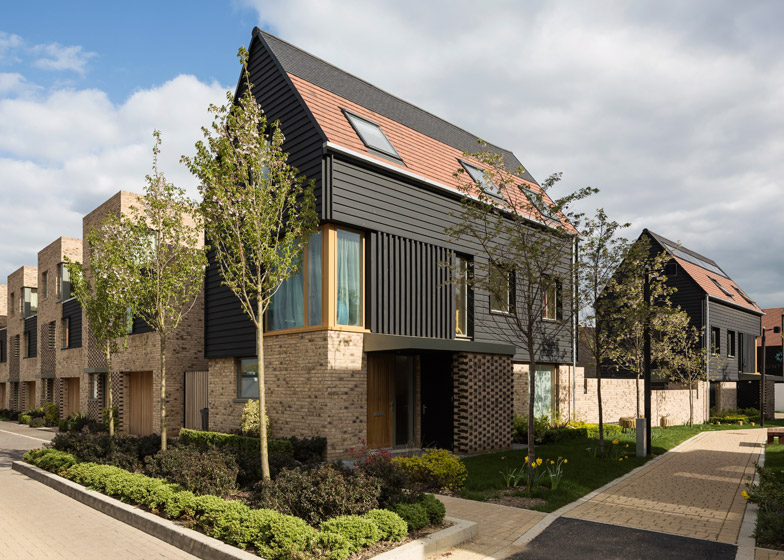Patterned brickwork reveals the entrances to all homes in this development near Cambridge, England, designed by Proctor and Matthews Architects to bring a sense of continuity to the large site (+ slideshow).
Abode at Great Kneighton is a new development of 306 homes just outside Cambridge, ranging from studio apartments to five-bedroom houses.
Although the buildings features a variety of different forms and cladding materials, London-based Proctor and Matthews Architects chose to add alternating dark and light bricks at the entrances to help unify the scheme.
"The brick pattern is seen in different ways, rather like a musical motif, knitting the different typologies together despite their wide variety," architect Stephen Proctor told Dezeen.
The 6.4-hectare site was designed as a sequence of spaces, moving from an urban to rural scale as the homes get closer to the surrounding countryside.
It begins with terraces of townhouses and apartments at the entrance, followed by rows of mews homes in the middle of the site, and then individual houses at the edge of the development.
A limited palette of materials was used to accentuate this transition of spaces, with the dominant materials of brick and perforated aluminium at the entrance gradually replaced by timber as the housing gets less dense.
"This gives the development character, and avoids the bland uniformity that gives many volume housing schemes elsewhere a bad name," said Proctor.
"This softer edge suggests 'rural erosion' into the neighbouring farmland and a new country park."
The site's entrance was conceived as a "great court", inspired by the college courtyards of Cambridge. Both buildings and landscaping were designed to soften the appearance of a large roundabout that was already on the site.
"We used tall buildings and brick to establish a robust, solid presence at the entrance, and incorporated a landscaping scheme that features outdoor play and games facilities, and extensive planting, which encourages people to use this space," said Proctor.
Two five-storey apartment buildings were placed alongside the three-storey terraces in the entrance court to create a gateway facade.
They are clad in aluminium panels, with a perforated pattern inspired by the fan-vaulted ceiling of nearby King's College Chapel in Cambridge.
"We call these marker buildings," said Proctor. "They are carefully positioned in the great court so that either one will welcome you as you enter from any direction, like the gatehouses in Cambridge's courtyards."
Colonnades were used to add depth to the facades of the terraces at the entrance, so they appear less flat and imposing, and voids were cut through them to offer glimpses of the lower-density housing deeper in the site.
Behind the entrance courtyard, there is an orderly grid of mews terraces, with rows bookended by pitched-roof houses.
Here, patterned brickwork was added to highlight entrances of the homes and "give depth and character to what would otherwise be flat facades," according to Proctor.
The architects worked closely with Harriet Bourne at BBUK Landscape Architecture to create the public spaces around the homes.
Kerbs and steps were avoided to make all homes wheelchair accessible and landscaped pathways were designed between the mews terraces to create 'green corridors' from the front to the back of the site.
"These quality shared spaces mean the streetscape is inhabited, which helps to create a sense of place and community," said Proctor.
At the back of the site, the grid of mews homes gives way to a more village-like layout, with houses arranged around narrow streets and winding paths.
Black Douglas fir was chosen as the main material here in order to reference local rural architecture, and was laid vertically and horizontally to enliven the facades, similar to the use of bricks on the mews terraces.
Affordable homes make up 40 per cent of the development's housing and are spread across the site, with an average cluster of eight per location.
"There is no difference in terms of design, volume or quality between any type of the housing on the site," said Proctor. "For us, that is critical in creating a successful community."
The 306 homes form the first phase of a wider development, which will eventually provide around 2,300 new homes across an area of approximately 101 hectares, as well as new schools, healthcare facilities, shops and transport links.
It follows in the footsteps of the Stirling Prize-winning Accordia housing development, which was completed in the same area in 2008. Like Abode Great Kneighton, it aimed to set an example for high-density housing developments.
"The main challenge in creating a development like this is creating a real 'place' within a volume housing context," said Proctor.
"We wanted to show that it was possible to create variety, a sense of identity and a richness of character with a limited palette – something which we hope other volume designers and house builders might take note of."
Photography is by Tim Crocker.









